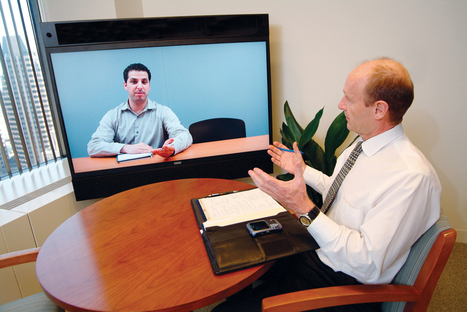Using telehealth technology still requires good bedside manners - just call it your screen side or website manners. So what do providers need to know that is different between an in-person encounter compared to a telehealth encounter?
The space involved with making that first impression via telehealth is significantly smaller than meeting in-person in a clinical setting. Besides being two-dimensional, your space is limited to the size and quality of the monitor projecting your image on the other end of the connection.
You only get one chance to make a first impression – so make it good.
Important factors to consider to help develop and maintain a positive patient-provider relationship:
Prior to encounter – being prepared is always the best practice.
- Equipment – understand how to use and test; know who to contact to troubleshoot; ensure good placement of the camera, microphone, and speakers
- Physical space – clear of distractions; good lighting; private and secure (HIPAA)
- Provider Appearance – professional; solid, non-distracting (preferably light blue) colors
- Preparation – review patient history chart/file
During the encounter – a little extra explanation can go a long way to foster relationships.
- Confirm connection quality (hear/see) and security of space (HIPAA)
- Introduce self (and others), organization/location
- Have patient introduce self and any others in the room
- Explain the process of taking notes, and only briefly looking away from the camera as necessary, otherwise maintain eye contact
- Periodically ask the patient if he/she has any questions or anything to say
- Reiterate any instructions or follow-up procedures for a patient prior to disconnecting
Developing your screen-side manners in today’s telehealth world is just as essential as developing good bedside manners.
Patients still need to feel they are being heard and understood by their provider whether in-person or via video connection. The tasks that happen during an in-person visit, (e.g., jotting down notes, or looking at an image), are seen directly by the patient.
These same actions may not be as visible via video, and require some explanation to keep the patient engaged. The patient still needs your full attention.
Empathy is no less important in telemedicine. Being prepared, clearly communicating, and focusing on your patient will help foster a positive patient-provider relationship.
You can still make meaningful eye contact via telehealth, but the trick is looking directly at the actual camera, and not the projected image of the patient on your screen.
Body language can speak louder than words, but telehealth creates a situation where not all body language is actually visible.
While a thoughtful hand to the chin while thinking maybe commonplace, on video the same action might communicate disinterest.
Controlling reactionary movements is vital for telehealth. While standing bedside, a simple action like shifting weight from one leg to another has minimal visual impact compared to being on video and then seeming to shift out of the view of the camera.
Similar to developing a good bedside manner, a good screen-side manner takes practice. Telehealth is unique in that you can record yourself and review the video before ever connecting with a patient.
By examining your recording, you can get a better understanding of the patient’s perspective of the telehealth connection. This process allows you to make adjustments that might not happen otherwise, creating the best patient encounter possible.



 Your new post is loading...
Your new post is loading...








Acheter MDMA Molly Ecstasy au Canada
L’ecstasy (MDMA) est à la fois une substance stimulante (de type amphétamine) et légèrement calmante (tranquillisante)
https://recherchechimique.com/
https://recherchechimique.com/produit/extase-molly/
https://recherchechimique.com/produit/bleu-et-jaune-ikea-mdma-220mg/
https://recherchechimique.com/produit/acheter-vyvanse-en-ligne/
https://recherchechimique.com/produit/brun-donkey-kong-mdma-260mg/
https://recherchechimique.com/produit/acheter-adderall-xr-en-ligne/
https://recherchechimique.com/produit/acheter-du-cristal-de-mdma-en-ligne/
https://recherchechimique.com/produit/acheter-du-marbre-hash-en-ligne/
https://recherchechimique.com/produit/acheter-3-meo-pcp-en-ligne/
https://recherchechimique.com/produit/acheter-acquista-xanax-2mg-en-ligne/
https://recherchechimique.com/produit/acheter-de-lheroine-en-ligne/
https://recherchechimique.com/produit/acheter-de-la-codeine-en-ligne/
https://recherchechimique.com/produit/acheter-de-la-methadone-en-ligne/
https://recherchechimique.com/produit/acheter-de-la-morphine-en-ligne/
https://recherchechimique.com/produit/acheter-hydrocodone-en-ligne/
https://recherchechimique.com/produit/acheter-oxycontin-en-ligne/
https://recherchechimique.com/produit/acheter-percocet-en-ligne/
https://recherchechimique.com/produit/ayahuasca-dmt/
https://recherchechimique.com/produit/bonbons-au-lsd/
https://recherchechimique.com/produit/buvards-lsd/
https://recherchechimique.com/produit/comprimes-de-gel-de-lsd/
https://recherchechimique.com/produit/cristaux-de-ketamine/
https://recherchechimique.com/produit/deadhead-chimiste-dmt/
https://recherchechimique.com/produit/glace-methamphetamine/
https://recherchechimique.com/produit/ketamine-hcl/
Se le ofrece medicación sin receta, Farmacia España. – una de las farmacias más confiables de España, con más de 20 años de experiencia dispensando medicamentos de calidad
https://drogaspoderosas.com/producto/comprar-adderall-xr/
https://drogaspoderosas.com/producto/comprar-adipex-en-linea/
https://drogaspoderosas.com/producto/comprar-ambien-en-linea/
https://drogaspoderosas.com/producto/comprar-ativan/
https://drogaspoderosas.com/producto/comprar-blue-xanax/
https://drogaspoderosas.com/producto/comprar-botox-en-linea/
https://drogaspoderosas.com/producto/comprar-codeina/
https://drogaspoderosas.com/producto/comprar-demerol-50mg-ml/
https://drogaspoderosas.com/producto/comprar-diazepam-en-linea/
https://drogaspoderosas.com/producto/comprar-dilaudid-8mg/
https://drogaspoderosas.com/producto/comprar-efedrina-hcl-30mg/
https://drogaspoderosas.com/producto/comprar-endocet-en-linea/
https://drogaspoderosas.com/producto/comprar-green-xanax/
https://drogaspoderosas.com/producto/comprar-hidrocodona-en-linea/
https://drogaspoderosas.com/producto/comprar-metadona-10mg/
https://drogaspoderosas.com/producto/comprar-morfina-15mg/
https://drogaspoderosas.com/producto/comprar-opana-en-linea/
https://drogaspoderosas.com/producto/comprar-stilnox-en-linea/
https://drogaspoderosas.com/producto/comprar-oxicodona-en-linea/
https://drogaspoderosas.com/producto/comprar-oxycontin-en-linea/
https://drogaspoderosas.com/producto/comprar-percocet-10mg-325mg/
https://drogaspoderosas.com/producto/comprar-rohipnol-2mg/
https://drogaspoderosas.com/producto/comprar-stilnox-en-linea/
https://drogaspoderosas.com/producto/comprar-suboxone-8mg/
https://drogaspoderosas.com/producto/comprar-subutex-8mg/
https://drogaspoderosas.com/producto/comprar-tableta-demerol/
https://drogaspoderosas.com/producto/comprar-vicodin-en-linea/
https://drogaspoderosas.com/producto/comprar-vyvanse-en-linea/
https://drogaspoderosas.com/producto/comprar-xanax-2mg/
https://drogaspoderosas.com/producto/compre-ritalin-en-linea/
https://drogaspoderosas.com/producto/parches-de-fentanilo/
Acheter MDMA Molly Ecstasy au Canada
L’ecstasy (MDMA) est à la fois une substance stimulante (de type amphétamine) et légèrement calmante (tranquillisante)
https://recherchechimique.com/
https://recherchechimique.com/produit/extase-molly/
https://recherchechimique.com/produit/bleu-et-jaune-ikea-mdma-220mg/
https://recherchechimique.com/produit/acheter-vyvanse-en-ligne/
https://recherchechimique.com/produit/brun-donkey-kong-mdma-260mg/
https://recherchechimique.com/produit/acheter-adderall-xr-en-ligne/
https://recherchechimique.com/produit/acheter-du-cristal-de-mdma-en-ligne/
https://recherchechimique.com/produit/acheter-du-marbre-hash-en-ligne/
https://recherchechimique.com/produit/acheter-3-meo-pcp-en-ligne/
https://recherchechimique.com/produit/acheter-acquista-xanax-2mg-en-ligne/
https://recherchechimique.com/produit/acheter-de-lheroine-en-ligne/
https://recherchechimique.com/produit/acheter-de-la-codeine-en-ligne/
https://recherchechimique.com/produit/acheter-de-la-methadone-en-ligne/
https://recherchechimique.com/produit/acheter-de-la-morphine-en-ligne/
https://recherchechimique.com/produit/acheter-hydrocodone-en-ligne/
https://recherchechimique.com/produit/acheter-oxycontin-en-ligne/
https://recherchechimique.com/produit/acheter-percocet-en-ligne/
https://recherchechimique.com/produit/ayahuasca-dmt/
https://recherchechimique.com/produit/bonbons-au-lsd/
https://recherchechimique.com/produit/buvards-lsd/
https://recherchechimique.com/produit/comprimes-de-gel-de-lsd/
https://recherchechimique.com/produit/cristaux-de-ketamine/
https://recherchechimique.com/produit/deadhead-chimiste-dmt/
https://recherchechimique.com/produit/glace-methamphetamine/
https://recherchechimique.com/produit/ketamine-hcl/